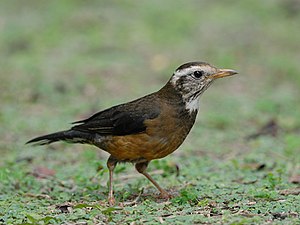South Sea Thrush
| South Sea Thrush | ||||||||||||
|---|---|---|---|---|---|---|---|---|---|---|---|---|

South Sea Thrush ( Turdus poliocephalus ), female |
||||||||||||
| Systematics | ||||||||||||
|
||||||||||||
| Scientific name | ||||||||||||
| Turdus poliocephalus | ||||||||||||
| Latham , 1801 |
The South Sea thrush ( Turdus poliocephalus ) is a 23–26 centimeter tall representative of the thrush family .
Appearance
The kind is colored very differently depending on the distribution area. The subspecies ( Turdus poliocephalus papuensis ) is completely black and has an orange beak and orange legs. The subspecies ( Turdus poliocephalus niveiceps ) has a white head, the belly is brownish. The back and tail are colored black. The beak and legs are yellow. Males and females are colored the same, the plumage of the male is more strongly colored.
distribution and habitat
This bird species occurs on Christmas Island , the island of Taiwan , in Indonesia , New Caledonia , on the Melanesia archipelago and other Pacific islands as far as Samoa and Fiji . The South Sea thrush lives there in rainforests, forest edges and clearings. On the island of New Guinea , it can be found in the mountains above the tree line at an altitude of 2300 to 4000 meters. On Viti Levu it occurs at all altitudes from the sea coast to the mountain peaks at an altitude of 1000 meters. It can also be found on flat coral islands.
Subspecies
About 50 subspecies are distinguished. These usually show only very small gradations in the color of the plumage.
| subspecies | distribution |
|---|---|
| Turdus poliocephalus layardi | Viti Levu |
| Turdus poliocephalus papuensis | Fiji Islands |
Turdus poliocephalus celebensis Distribution: New Guinea
Turdus poliocephalus carbonarius Distribution: Papua New Guinea
Turdus poliocephalus thomassoni Distribution: Luzon
Turdus poliocephalus niveiceps Distribution: Taiwan
Turdus poliocephalus javanicus Distribution: Java
Turdus poliocephalus pritzbueri Distribution: Vanua Levu
Norfolk Island Thrush † (extinct) Turdus poliocephalus poliocephalus Distribution: Norfolk Island
Lord Howe Island Thrush † (extinct) Turdus poliocephalus vinitinctus Distribution: Lord Howe Island
Three subspecies, the Norfolk Island Thrush ( Turdus poliocephalus poliocephalus ), the subspecies on Maré Island ( Turdus poliocephalus mareensis ), and Lord Howe Island Thrush ( Turdus poliocephalus vinitinctus ) are already extinct.
Way of life
These birds have a flute-like song. They are loners and usually hide in tall trees. To search for food, they look for open areas such as fields. The South Sea thrush feeds mainly on plant seeds, fruits, and occasionally also on insects, worms and snails that they find on the ground.
Reproduction
The bowl-shaped nest is built by the South Sea thrush, depending on its distribution, on a wide variety of surfaces such as rock ledges, bushes or on a rock reef. The female usually only lays one egg. The incubation period is between 11 and 18 days. After that, the young remain in the nest for up to 18 days. Both parents look after the boys.
Hazards and protective measures
Although this species is slowly declining due to the destruction of its habitat, it is still relatively common and widespread and is therefore still not classified as endangered by the IUCN ( Least Concern ).
literature
- Christopher M. Perrins : The Great Encyclopedia of Birds. From the English, Orbis-Verlag, Munich 1996, ISBN 3-572-00810-7 , pp. 271, 273.
- Philip Whitfield (ed.): The great world empire of the animals . S. 336, 337, Planet Medien AG, Zug 1992, (German translation from English) ISBN 3-8247-8614-1 .
- Goetz Rheinwald: Atlas of the bird world . P. 172, UNIPART VERLAG GmbH, Remseck near Stuttgart 1994 (German translation from English) ISBN 3-8122-3399-1 .
- Christopher M. Perrins (Ed.): The FSVO encyclopedia birds of the world. Translated from the English by Einhard Bezzel. BLV, Munich / Vienna / Zurich 2004, ISBN 978-3-405-16682-3 , p. 526 (title of the original English edition: The New Encyclopedia Of Birds. Oxford University Press, Oxford 2003).
Web links
- Turdus poliocephalus inthe IUCN Red List of Threatened Species 2017.3. Posted by: BirdLife International, 2016. Retrieved December 26, 2017.







